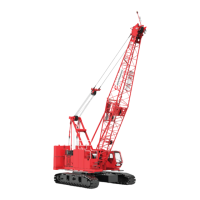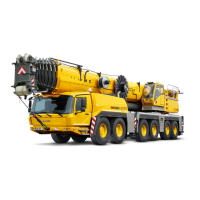SET-UP AND INSTALLATION MLC650 OPERATOR MANUAL
4-136
Published 08-12-19, Control # 224-13_v2
RAISE BOOM
NOTE: Refer to the MLC650 Luffing Jib Operator Manual
for the pre-raising checks and raising procedure
when equipped with a luffing jib.
Pre-Raising Checks
Perform the following checks before raising the boom and
jib:
Maintenance and lubrication checks have been
performed according to Maintenance Checklist and
Lubrication Guide.
Crane is on a firm, level surface.
Crawlers are blocked if required per capacity chart in
use.
Boom hinge pins are fully engaged and secured.
Crawler connecting pins are engaged and locking pins
installed.
Carbody jack pads are removed and secured in storage
position.
Carbody jacks are fully retracted and stored.
Boom and jib inserts are installed in proper sequence
per boom and jib assembly drawings.
Intermediate wire rope guide (if required) is installed at
proper insert.
Intermediate suspension insert (if required) is installed in
proper position.
Intermediate suspension pendants (if required) are
secured in proper operating position and sockets are in
working position.
Drop-down suspension (if required) is installed in proper
position.
Drop-down suspension pendants (if required) are
secured in proper operating position and sockets are in
working position.
All straps are properly pinned together. Cotter pins are
installed and spread.
Live mast straps are properly connected to boom straps.
Mast-assist arms are fully lowered.
Boom hoist wire rope is spooled tightly onto boom hoist
and engaged with the proper sheaves.
Load lines are spooled tightly onto drums and engaged
with proper sheaves.
Load lines are securely anchored at boom and jib points
or at load block and weight ball.
Left-rear rotating bed ladder is folded in stored position
or removed.
All tools and other items are removed from boom and jib.
Electrical boom stop is properly installed, operational,
and adjusted to proper angle.
Electric cables from crane control system are connected
to cable reel in boom butt.
Electric cables in boom and jib are connected to proper
receptacles.
Block-up limit control is properly installed, operational,
and adjusted.
RCL/RCI is properly configured and operational.
Proper capacity chart is selected on configuration
screen of RCL/RCI display.
Operator has read and is thoroughly familiar with
selected capacity chart. Consult the selected capacity
chart for applicable deducts and boom length raising
limitations.
Wind is within allowable limits for operation as shown in
Wind Conditions document located at end of Section 3.
Boom Raising Procedure
1. Verify that the pre-raising checks have been performed.
2. SLOWLY start to boom up:
a. Have an assistant watch the boom straps as the
boom rises.
Signal the operator to STOP raising the boom if the
straps get caught on the brackets, pins, or timber
guards. Correct the problem before continuing.
b. If equipped with suspension pendants —
- intermediate: perform step 7
(a through h) on
page 4-135)
-drop-down: perform step 19
(a through f) on
page 4-101
Signal the operator to STOP raising the boom if the
pendants get caught or do not rise smoothly out of
the inserts. Correct the problem before continuing.
3. SLOWLY continue to boom up.
4. When there is enough tension on the straps, the
operating limit will become active indicating to switch to
VPC Setup Mode.
5. If equipped with an upper boom point, stop when the
bottom holes in the upper boom point are aligned with
the holes in the boom top. Install the connecting pins.
Figure 4-85 on page 4-112
.
